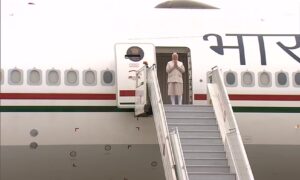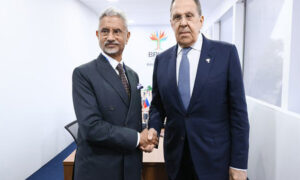
South Asia is extremely vulnerable to a range of climate impacts, ranging from shrinking glaciers and water scarcity to floods and rising sea levels. Shifting monsoon patterns and heat waves place noticeable stress on South Asian countries, whose primary employment sector remains agriculture. Especially, floods and droughts have not only become more regular, but also more severe. The recent flood in Kerala clearly shows the risks of climate change to the South Asian countries and societies.
Responding to these risks is always difficult. The increasing severity of the impacts – that often affects more than one country – exceeds the capacity of national governments, making adequate responses more difficult. With the South Asian Association for Regional Cooperation (SAARC), South Asian states have a viable regional player that can support national governance responses, but is SAARC prepared for to combat climate change and its security risks?
A new study by the Stockholm International Peace Research Institute, SIPRI, shows that since 1987, in their Kathmandu Declaration, all the heads of states of SAARC have expressed ‘their deep concern’ for the regional challenges related to environmental degradation and climate change. They have recognised that these challenges are ‘severely undermining the development process and prospects of the member countries’, and they have ‘decided to intensify regional cooperation with a view to strengthening their disaster management capabilities.’ In order to do so, SAARC commissioned a study on the Protection and Preservation of the Environment and the Causes and Consequences of Natural Disasters, which was finalised in 1991. The Technical Committee on Environment, established in 1992, was subsequently tasked with identifying measures for immediate action and deciding modalities for implementation. Since then, its mandate has been expanded to also include forestry.
In several declarations, SAARC has expressed a concern for environmental issues including climate change. However, it took until 2005—in the aftermath of the 2004 Indian Ocean tsunami—before SAARC members agreed on concrete actions to address natural disasters. Despite the fact that this event was not caused by climate change, the frameworks established by member states in the aftermath address both natural and climate-related disasters. Indeed, the Comprehensive Framework on Disaster Management (2006–15) is aligned with the Hyogo Framework for Action (2005–15) of the UN International Strategy for Disaster Reduction (UNISDR). Part of the framework led to the creation of the SAARC Disaster Management Centre (SDMC) in October 2006, in order to advise policy and facilitate capacity building. In 2008, SAARC agreed on the Natural Disaster Rapid Response Mechanism under the guidance of the SDMC, in order to adopt a coordinated and planned approach to natural disasters. In November 2016, the SDMC merged the SAARC Meteorological Research Centre, the SAARC Forestry Centre and the SAARC Coastal Zone Management Centre.
Climate-related security risks, beyond natural disasters, were broadly emphasised in the 2007 Declaration of the 14th SAARC Summit, with heads of state expressing ‘deep concern over global climate change and the consequent rise in sea level and its impact on the lives and livelihoods in the region’. Consequently, they called for cooperation on climate action, including early warning and knowledge sharing for ‘pursuing a climate resilient development in South Asia’. This resulted in the three-year SAARC Action Plan on Climate Change in 2008, which identifies seven thematic areas of cooperation, among which adaptation, mitigation, and management of impacts and risk deal with climate change-related security risks.
The accompanying SAARC Environment Ministers Dhaka Declaration on Climate Change notably emphasises that ‘climate change is substantively the result of the greenhouse gas emissions by the developed world for over two centuries’. The latter statement is connected to the demand to receive international financial support, a common demand of many developing regions. In 2010, following the Thimphu Statement on Climate Change, SAARC established an Expert Group on Climate Change to ensure policy direction and guidance for regional cooperation. Within most SAARC declarations, the role of the UN Framework Convention on Climate Change (UNFCCC) and the National Adaptation Programmes of Action (NAPAs) is emphasised as a focal point of climate action. SAARC does not provide climate-related financing, thus most of the climate-related projects are implemented at a national level through various funds within the UNFCCC framework.
SAARC also has specific frameworks for food security, such as the 1987 Agreement on Establishing the SAARC Food Security Reserve, which had several problems in becoming effectively operational. In 2004 SAARC endorsed a proposal to create a Regional Food Bank, which was then established in 2007. In 2011 SAARC member states agreed to establish a SAARC Seed Bank, however, it is dysfunctional and has only been ratified by five countries. Finally, the Framework for Material Transfer Agreement is an Annex to the Seed Bank Agreement that establishes a mechanism for the exchange of seeds and other materials, in order to achieve food security and address natural and man-made disasters.
Despite a significant number of declarations to combat climate change and its security risks, many policies are still not operational, and others are yet to be ratified. As scholars often point out that though several institutions have been established, they have not been able to produce concrete results in accordance with declarations, conventions and action plans produced at SAARC.
One such example is the SAARC Food Bank, which was first launched in 1987, then relaunched in 2004. Following two flood events in 2017, Bangladesh faced food insecurity, but could not utilize the SAARC Food Bank due to inadequate reserves, an overburdening bureaucratic procedure, and complicated financial details in terms of pricing and funding. Similarly, the SDMC, which was initiated to advise on policy and facilitate capacity building on natural disaster response is currently undergoing reform and has so far produced little work.
SAARC has also implemented the South Asia Disaster Knowledge Network (SADKN) (2009–12), which is mainly funded by the World Bank’s Global Facility for Disaster Reduction and Recovery through UNISDR. The SADKN is a significant platform for sharing knowledge and information about disaster risk reduction management in South Asia. However, cooperation within the SADKN only exists on a bilateral level and through alternative regional configurations.
Smaller South Asian countries in particular, such as Bangladesh, Bhutan, Nepal, the Maldives and Sri Lanka have developed their climate security collaboration at a bilateral level and through non-governmental pathways. One of these initiatives is the Asian Disaster Preparedness Centre, which brings together the national disaster management organisations of different countries in the region to facilitate the implementation of disaster and climate risk management.
Climate-related security risks in the South Asia are not only regional but also multidimensional. The risks from the climate change span different security sectors, such as economic, political, military, and, of course, environmental security. Thus, climate change creates new challenges for regional organisations, and simultaneously increases their relevance.
Though SAARC has been aware of its role and importance, it has not been able to translate that willingness into concrete actions. The division within the SAARC members, particularly India’s recent effort to isolate Pakistan within SAARC, has rendered the regional organisation virtually ineffective in achieving any of its stated objectives, particularly on the climate front. In order to better support its member states to mitigate and adapt to climate-related security risks, South Asian states – especially India and Pakistan – will have to find a way to set aside long-standing mistrust and find the will to cooperate. Newly elected Pakistani Minister Imran Khan has been highlighting the threat of the climate change to his country. In June 2017, India’s Prime Minister Narendra Modi has assured the world that his country will go ‘above and beyond’ the 2015 Paris Accord to combat climate change. It is high time that Imran Khan and Narendra Modi join hands in revitalising SAARC in order to make it an effective organisation, which can bring the region together to combat climate change and its grave security risks.
Florian Krampe is researcher at the Stockholm International Peace Research Institute, Sweden; Ashok Swain is professor of Peace and Conflict Research at Uppsala University, Sweden
This article was originally published in the Third Pole. To read the original article click here :


















